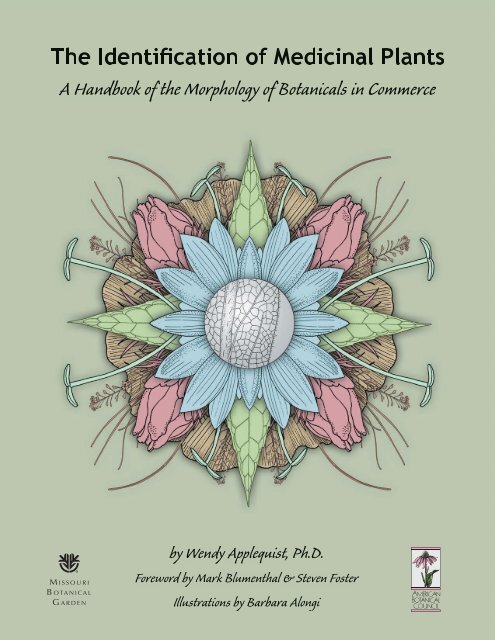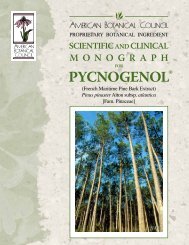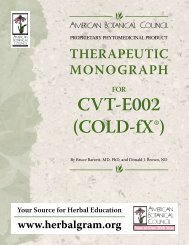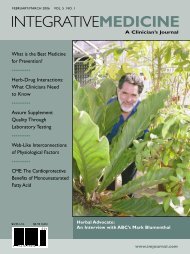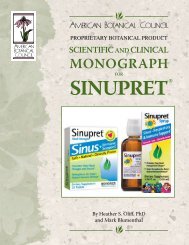The Identification of Medicinal Plants A ... - American Botanical Council
The Identification of Medicinal Plants A ... - American Botanical Council
The Identification of Medicinal Plants A ... - American Botanical Council
You also want an ePaper? Increase the reach of your titles
YUMPU automatically turns print PDFs into web optimized ePapers that Google loves.
<strong>The</strong> Identifi cation <strong>of</strong> <strong>Medicinal</strong> <strong>Plants</strong><br />
A Handbook <strong>of</strong> the Morphology <strong>of</strong> <strong>Botanical</strong>s in Commerce<br />
by Wendy Applequist, Ph.D.<br />
Foreword by Mark Blumenthal & Steven Foster<br />
Illustrations by Barbara Alongi
Th e Identifi cation <strong>of</strong> <strong>Medicinal</strong> <strong>Plants</strong><br />
A Handbook <strong>of</strong> the Morphology <strong>of</strong> <strong>Botanical</strong>s in Commerce<br />
Missouri <strong>Botanical</strong> Garden<br />
St. Louis, Missouri<br />
By Wendy Applequist, Ph.D.<br />
Illustrations by Barbara Alongi<br />
With a Foreword by<br />
Mark Blumenthal<br />
Founder and Executive Director<br />
<strong>American</strong> <strong>Botanical</strong> <strong>Council</strong><br />
and<br />
Steven Foster<br />
President, Steven Foster Group<br />
Botanist and Author<br />
A joint project <strong>of</strong><br />
2006<br />
<strong>American</strong> <strong>Botanical</strong> <strong>Council</strong><br />
Austin, Texas
About the Author<br />
Wendy Applequist earned her Ph.D. in plant systematics from Iowa State University and is an assistant curator in<br />
the William L. Brown Center for Plant Genetic Resources at the Missouri <strong>Botanical</strong> Garden. She conducts research on<br />
the botany <strong>of</strong> medicinal plants and plants native to Madagascar. She has previously published articles in several journals,<br />
including Systematic Botany, Taxon, Plant Systematics and Evolution, Evolution and Development, Pharmazie, Flora, and<br />
Adansonia. Th is is her fi rst book.<br />
About the Artist<br />
Barbara Alongi is a scientifi c illustrator based at the Missouri <strong>Botanical</strong> Garden. Her illustrations accompany many<br />
descriptions <strong>of</strong> new species <strong>of</strong> plants as well as monographic treatments. She is an illustrator for the Flora <strong>of</strong> North<br />
America project.
About the <strong>American</strong> <strong>Botanical</strong> <strong>Council</strong><br />
Th e <strong>American</strong> <strong>Botanical</strong> <strong>Council</strong> (ABC) is the leading independent, nonpr<strong>of</strong>i t education and research organization<br />
using science-based and traditional information to promote the responsible use <strong>of</strong> herbal medicine. Th e membersupported<br />
organization serves all populations interested in herbal medicine: the general public, healthcare pr<strong>of</strong>essionals,<br />
researchers, educators, industry, media and government.<br />
ABC’s vision is that the public makes educated, responsible choices about herbal medicine as an accepted part <strong>of</strong><br />
healthcare. Founded in 1988, ABC supports this vision through its mission to provide science-based and traditional<br />
information to promote the responsible use <strong>of</strong> herbal medicine. ABC achieves its mission through:<br />
• Publication <strong>of</strong> its peer-reviewed journal<br />
HerbalGram<br />
• HerbClip literature review service<br />
• HerbalEGram electronic newsletter<br />
• Publication <strong>of</strong> books and literature<br />
• Information on its website, www.herbalgram.org<br />
About the Missouri <strong>Botanical</strong> Garden<br />
• Continuing education materials for healthcare<br />
prr<strong>of</strong>essionals<br />
• Internships for healthcare pr<strong>of</strong>essionals<br />
• Safety guidelines for herbal products<br />
• Seminars, presentations and workshops<br />
• Serving as a source <strong>of</strong> authoritative information to<br />
global print and electronic media<br />
For information:<br />
<strong>American</strong> <strong>Botanical</strong> <strong>Council</strong><br />
P.O. Box 144345<br />
Austin, TX 78714-4345<br />
Phone: 512-926-4900<br />
Fax: 512-926-2345<br />
Toll free in the U.S.: 800-373-7105<br />
Email: ABC@HerbalGram.org.<br />
Website: www.HerbalGram.org<br />
Th e oldest continuously operating botanical garden west <strong>of</strong> the Mississippi, the Missouri <strong>Botanical</strong> Garden <strong>of</strong> St. Louis<br />
is an award-winning horticultural and educational institution whose many public attractions run the gamut from an oldfashioned<br />
herb garden to a brand-new Children’s Garden. Behind the scenes, it is also one <strong>of</strong> the world’s most active centers<br />
for botanical systematic and fl oristic research, with about 150 full-time research staff who conduct fi eld studies in dozens<br />
<strong>of</strong> countries every year. Th e Garden’s mission is “To discover and share knowledge about plants and their environment, in<br />
order to preserve and enrich life”. Th e Garden’s William L. Brown Center for Plant Genetic Resources focuses its research<br />
specifi cally on the identifi cation, scientifi c study, and preservation <strong>of</strong> plants that are <strong>of</strong> direct use to humans.<br />
vi<br />
Th e Identifi cation <strong>of</strong> <strong>Medicinal</strong> <strong>Plants</strong>:
Table <strong>of</strong> Contents<br />
Table <strong>of</strong> Figures ............................................................................................................................ xi<br />
Foreword .................................................................................................................................... xiii<br />
Acknowledgements ......................................................................................................................xvi<br />
Introduction ...............................................................................................................................xvii<br />
Background ................................................................................................................................... 1<br />
Basics <strong>of</strong> Plant Morphology .....................................................................................................................3<br />
Practical Plant Identifi cation ....................................................................................................................7<br />
<strong>Botanical</strong> Nomenclature ...........................................................................................................................9<br />
Description <strong>of</strong> <strong>Botanical</strong> Entries ............................................................................................................11<br />
<strong>Botanical</strong> Entries ......................................................................................................................... 13<br />
Achillea millefolium L. (Yarrow) ...............................................................................................................14<br />
Actaea racemosa L. (Black Cohosh) ..........................................................................................................16<br />
Adonis vernalis L. (Spring Adonis) .........................................................................................................18<br />
Aesculus hippocastanum L. (Horse Chestnut) ...........................................................................................20<br />
Agathosma betulina (P. J. Bergius) Pillans, A. crenulata (L.) Pillans, A. serratifolia (Curtis)<br />
Spreeth (Buchu) ..............................................................................................................................21<br />
Althaea <strong>of</strong>fi cinalis L. (Marshmallow) .......................................................................................................22<br />
Andrographis paniculata (Burm. f.) Nees (Andrographis) ........................................................................23<br />
Angelica sinensis (Oliv.) Diels (Dong Quai) ............................................................................................. 25<br />
Apium graveolens L. (Celery) ...................................................................................................................26<br />
Arctostaphylos uva-ursi (L.) Spreng. (Uva-Ursi).......................................................................................27<br />
Arnica montana L. (Arnica) .....................................................................................................................29<br />
Artemisia absinthium L. (Wormwood) ....................................................................................................31<br />
Artemisia annua L. (Sweet Wormwood) .................................................................................................32<br />
Astragalus mongholicus Bunge (Astragalus) ..............................................................................................34<br />
Berberis aquifolium Pursh, B. nervosa Pursh, B. repens Lindl. (Oregon Grape) ........................................36<br />
Berberis vulgaris L. (Barberry) .................................................................................................................37<br />
Betula pendula Roth, B. pubescens Ehrh. (Birch) ......................................................................................38<br />
Calendula <strong>of</strong>fi cinalis L. (Calendula) .........................................................................................................39<br />
Capsella bursa-pastoris (L.) Medik. (Shepherd’s Purse) ...........................................................................41<br />
A Handbook <strong>of</strong> the Morphology <strong>of</strong> <strong>Botanical</strong>s in Commerce vii
Carum carvi L. (Caraway) .......................................................................................................................42<br />
Caulophyllum thalictroides (L.) Michx. (Blue Cohosh) ............................................................................44<br />
Centella asiatica (L.) Urb. (Gotu Kola) ....................................................................................................45<br />
Chamaelirium luteum (L.) A. Gray (False Unicorn) ................................................................................46<br />
Chamaemelum nobile (L.) All. (Roman Chamomile) ...............................................................................48<br />
Cichorium intybus L. (Chicory) ...............................................................................................................49<br />
Coriandrum sativum L. (Coriander) ........................................................................................................50<br />
Crataegus laevigata (Poir.) DC, Crataegus monogyna Jacq. (Hawthorn) ................................................... 51<br />
Crocus sativus L. (Saff ron) .......................................................................................................................54<br />
Cucurbita pepo L. (Pumpkin) ...................................................................................................................55<br />
Cytisus scoparius (L.) Link (Scotch Broom) ............................................................................................56<br />
Dioscorea villosa L. (Wild Yam) ..............................................................................................................57<br />
Echinacea angustifolia DC. (Echinacea angustifolia); E. pallida (Nutt.) Nutt. (Echinacea pallida) ............58<br />
Echinacea purpurea (L.) Moench (Echinacea purpurea) ............................................................................60<br />
Eleutherococcus senticosus (Rupr. & Maxim.) Maxim. (Eleuthero) ............................................................62<br />
Epimedium brevicornu Maxim., E. grandifl orum C. Morren, E. koreanum Nakai, E. pubescens<br />
Maxim., E. sagittatum (Sieb. & Zucc.) Maxim., E. wushanense T. S. Ying (Epimedium)..................63<br />
Equisetum arvense L. (Horsetail) .............................................................................................................66<br />
Euphrasia <strong>of</strong>fi cinalis L. (Eyebright) ..........................................................................................................68<br />
Fallopia japonica (Houtt.) Ronse Decraene ( Japanese Knotweed) ..........................................................70<br />
Filipendula ulmaria (L.) Maxim. (Meadowsweet) ...................................................................................71<br />
Foeniculum vulgare Mill. (Fennel) ...........................................................................................................72<br />
Frangula purshiana (DC.) J. G. Cooper (Cascara Sagrada) .....................................................................73<br />
Galium aparine L. (Cleavers)...................................................................................................................75<br />
Gentiana lutea L. (Gentian) ....................................................................................................................77<br />
Ginkgo biloba L. (Ginkgo) .......................................................................................................................79<br />
Glycyrrhiza glabra L. (Licorice) ...............................................................................................................80<br />
Hamamelis virginiana L. (Witch Hazel).................................................................................................81<br />
Hibiscus sabdariff a L. (Hibiscus) ..............................................................................................................82<br />
Hydrastis canadensis L. (Goldenseal) .......................................................................................................84<br />
Hypericum perforatum L. (St. John’s Wort) ..............................................................................................85<br />
Hyssopus <strong>of</strong>fi cinalis L. (Hyssop) ...............................................................................................................86<br />
Ilex paraguariensis A. St.-Hil. (Maté)......................................................................................................87<br />
Illicium verum Hook. f. (Star Anise) .......................................................................................................89<br />
Juniperus communis L. ( Juniper) ..............................................................................................................91<br />
Lavandula angustifolia Mill. (English Lavender) ....................................................................................92<br />
viii Th e Identifi cation <strong>of</strong> <strong>Medicinal</strong> <strong>Plants</strong>:
Ligusticum porteri J. M. Coult. & Rose (Osha) ........................................................................................93<br />
Linum usitatissimum L. (Flax) .................................................................................................................95<br />
Lobelia infl ata L. (Lobelia) ......................................................................................................................96<br />
Lycopus europaeus L. (European Bugleweed) ...........................................................................................98<br />
Lycopus virginicus L. (Bugleweed) ...........................................................................................................99<br />
Marrubium vulgare L. (Horehound) .....................................................................................................101<br />
Matricaria chamomilla L. (Chamomile) ................................................................................................104<br />
Medicago sativa L. (Alfalfa) ...................................................................................................................105<br />
Melissa <strong>of</strong>fi cinalis L. subsp. <strong>of</strong>fi cinalis (Lemon Balm) .............................................................................107<br />
Mentha ×piperita L. (Peppermint) .........................................................................................................109<br />
Mitchella repens L. (Partridge berry) ......................................................................................................110<br />
Olea europaea L. (Olive) ........................................................................................................................112<br />
Panax ginseng C. A. Mey. (Asian Ginseng); P. quinquefolius L. (<strong>American</strong> Ginseng) ...........................113<br />
Passifl ora incarnata L. (Passionfl ower) ...................................................................................................115<br />
Peumus boldus Molina (Boldo) ..............................................................................................................118<br />
Phyllanthus amarus Schumach. & Th onn. (Phyllanthus amarus) ............................................................119<br />
Phyllanthus fraternus G. L. Webster, P. niruri L., P. urinaria L. (Phyllanthus) .......................................122<br />
Pimpinella anisum L. (Anise) ................................................................................................................126<br />
Plantago afra L., P. arenaria Waldst. & Kit., P. asiatica L., P. ovata (Psyllium) ......................................128<br />
Plantago major L. (Plantain) .................................................................................................................130<br />
Prunella vulgaris L. (Heal All) ..............................................................................................................132<br />
Rhamnus cathartica L. (Buckthorn) .......................................................................................................134<br />
Rosmarinus <strong>of</strong>fi cinalis L. (Rosemary) .....................................................................................................135<br />
Rubus idaeus L. (Raspberry) ..................................................................................................................136<br />
Rumex crispus L. (Yellow Dock) ............................................................................................................138<br />
Salix alba L. (White Willow) ...............................................................................................................139<br />
Salvia <strong>of</strong>fi cinalis L. (Sage) ......................................................................................................................140<br />
Sambucus nigra L. (European Elder) .....................................................................................................142<br />
Sanguinaria canadensis L. (Bloodroot) ..................................................................................................145<br />
Schisandra chinensis (Turcz.) Baill. (Schisandra) ....................................................................................146<br />
Scutellaria laterifl ora L. (Skullcap) .........................................................................................................147<br />
Senna alexandrina Mill. (Senna) ...........................................................................................................150<br />
Serenoa repens (W. Bartram) Small (Saw Palmetto) ..............................................................................152<br />
Sida cordifolia L. (Heart-Leaf Sida) ......................................................................................................153<br />
Silybum marianum (L.) Gaertn. (Milk Th istle) .....................................................................................155<br />
Smilax aristolochiifolia Mill., S. febrifuga Kunth, S. regelii Killip & C. V. Morton (Sarsaparilla) ............156<br />
A Handbook <strong>of</strong> the Morphology <strong>of</strong> <strong>Botanical</strong>s in Commerce ix
Solidago virgaurea L. (European Goldenrod) ........................................................................................158<br />
Stellaria media (L.) Vill. (Chickweed) ...................................................................................................160<br />
Stevia rebaudiana (Bertoni) Bertoni (Stevia) ........................................................................................162<br />
Stillingia sylvatica Garden ex L. (Stillingia) ..........................................................................................163<br />
Tanacetum parthenium (L.) Sch. Bip. (Feverfew) ...................................................................................164<br />
Taraxacum <strong>of</strong>fi cinale F.H.Wigg. (Dandelion) ........................................................................................166<br />
Th ymus vulgaris L. (Th yme) ..................................................................................................................168<br />
Tilia cordata Mill., T. platyphyllos Scop., T. ×europaea L. (Linden) ........................................................170<br />
Trifolium pratense L. (Red Clover) ........................................................................................................172<br />
Trigonella foenum-graecum L. (Fenugreek) ............................................................................................173<br />
Turnera diff usa Willd. ex Schult. (Damiana) .........................................................................................174<br />
Tylophora indica (Burm. f.) Merr. (Tylophora asthmatica) .......................................................................175<br />
Ulmus rubra Muhl. (Slippery Elm) .......................................................................................................177<br />
Urtica dioica L. subsp. dioica (Stinging Nettle) ......................................................................................178<br />
Vaccinium macrocarpon Aiton (Cranberry) .............................................................................................180<br />
Vaccinium myrtillus L. (Bilberry) ...........................................................................................................181<br />
Valeriana <strong>of</strong>fi cinalis L. (Valerian) ............................................................................................................ 182<br />
Viburnum prunifolium L. (Black Haw) ..................................................................................................183<br />
Viscum album L. (European Mistletoe) .................................................................................................184<br />
Vitex agnus-castus L. (Chaste Tree) .......................................................................................................187<br />
Vitis vinifera L. (Grape) ........................................................................................................................188<br />
Withania somnifera (L.) Dunal (Ashwagandha)....................................................................................189<br />
Zingiber <strong>of</strong>fi cinale Roscoe (Ginger) .......................................................................................................190<br />
Appendix ...................................................................................................................................193<br />
General References ...............................................................................................................................194<br />
Glossary ................................................................................................................................................195<br />
Index .........................................................................................................................................205<br />
x<br />
Th e Identifi cation <strong>of</strong> <strong>Medicinal</strong> <strong>Plants</strong>:
Table <strong>of</strong> Figures<br />
Figure 1: Achillea millefolium ................................ 15<br />
Figure 2: Actaea racemosa, A. podocarpa,<br />
A. pachypoda, A. rubra .....................................17<br />
Figure 3: Adonis vernalis ....................................... 19<br />
Figure 4: Agathosma betulina, A. crenulata ............ 21<br />
Figure 5: Andrographis paniculata ......................... 24<br />
Figure 6: Apium graveolens, Ammi majus,<br />
Ammi visnaga .................................................... 26<br />
Figure 7: Arctostaphylos uva-ursi ........................... 28<br />
Figure 8: Arnica montana, A. chamissonis .........29-30<br />
Figure 9: Artemisia absinthium ............................. 31<br />
Figure 10: Artemisia annua ................................... 33<br />
Figure 11: Astragalus mongholicus ......................... 35<br />
Figure 12: Berberis aquifolium, B. repens ............... 36<br />
Figure 13: Betula pendula, B. pubescens .............38-39<br />
Figure 14: Calendula <strong>of</strong>fi cinalis .............................. 40<br />
Figure 15: Capsella bursa-pastoris ......................... 41<br />
Figure 16: Carum carvi, Cuminum cyminum ......... 43<br />
Figure 17: Centella asiatica ................................... 45<br />
Figure 18: Chamaemelum nobile ............................ 48<br />
Figure 19: Cichorium intybus ................................ 49<br />
Figure 20: Coriandrum sativum ............................ 50<br />
Figure 21: Crataegus laevigata, C. monogyna....52-53<br />
Figure 22: Echinacea pallida, E. angustifolia .......... 59<br />
Figure 23: Echinacea purpurea .............................61<br />
Figure 24: Epimedium sagittatum,<br />
E. grandifl orum ................................................ 64<br />
Figure 25: Equisetum arvense, E. palustre ............. 67<br />
Figure 26: Euphrasia <strong>of</strong>fi cinalis, E. stricta .............. 69<br />
Figure 27: Filipendula ulmaria.............................. 71<br />
Figure 28: Foeniculum vulgare ............................... 73<br />
Figure 29: Galium aparine,<br />
G. verum, G. odoratum ................................75-77<br />
Figure 30: Ginkgo biloba ....................................... 79<br />
Figure 31: Hamamelis virginiana .......................... 81<br />
Figure 32: Hibiscus sabdariff a ................................ 83<br />
Figure 33: Hypericum perforatum .......................... 85<br />
Figure 34: Hyssopus <strong>of</strong>fi cinalis ................................ 87<br />
Figure 35: Ilex paraguariensis ................................ 88<br />
Figure 36: Illicium verum, I. anisatum ................... 89<br />
Figure 37: Lavandula angustifolia, L. latifolia .......92<br />
Figure 38: Ligusticum porteri ................................94<br />
Figure 39: Linum usitatissimum ............................95<br />
Figure 40: Lobelia infl ata ................................ 96-97<br />
Figure 41: Lycopus europaeus ........................... 98-99<br />
Figure 42: Lycopus virginicus ...............................100<br />
Figure 43: Marrubium vulgare,<br />
M. perigrinum, Ballota hirsuta,<br />
B. nigra .................................................. 102-103<br />
Figure 44: Matricaria chamomilla,<br />
Anthemis cotula ...................................... 104-105<br />
Figure 45: Medicago sativa ..................................106<br />
Figure 46: Melissa <strong>of</strong>fi cinalis,<br />
Nepeta cataria ..................................... 107-108<br />
Figure 47: Mentha ×piperita, M. canadensis ........109<br />
A Handbook <strong>of</strong> the Morphology <strong>of</strong> <strong>Botanical</strong>s in Commerce xi
Figure 48: Mitchella repens ..................................111<br />
Figure 49: Olea europaea ............................. 112-113<br />
Figure 50: Panax quinquefolius ................... 114-115<br />
Figure 51: Passifl ora incarnata ............................117<br />
Figure 52: Peumus boldus ....................................118<br />
Figure 53: Phyllanthus amarus .................... 119-120<br />
Figure 54: Phyllanthus fraternus,<br />
P. niruri, P. urinaria ............................... 122-125<br />
Figure 55: Pimpinella anisum,<br />
Petroselinum crispum ......................................126<br />
Figure 56: Plantago afra, P. major .......................128<br />
Figure 57: Plantago major, P. lanceolata,<br />
Digitalis lanata ..............................................131<br />
Figure 58: Prunella vulgaris ................................133<br />
Figure 59: Rhamnus cathartica ............................134<br />
Figure 60: Rosmarinus <strong>of</strong>fi cinalis .........................135<br />
Figure 61: Rubus idaeus, R. fruticosus ..................137<br />
Figure 62: Salvia <strong>of</strong>fi cinalis, S. fruticosa ...............141<br />
Figure 63: Sambucus nigra ..................................143<br />
Figure 64: Sanguinaria canadensis ......................145<br />
Figure 65: Scutellaria laterifl ora,<br />
Teucrium canadense ................................ 148-149<br />
Figure 66: Senna alexandrina, S. italica ..............151<br />
Figure 67: Serenoa repens ....................................152<br />
Figure 68: Sida cordifolia .....................................153<br />
Figure 69: Silybum marianum .............................155<br />
Figure 70: Solidago virgaurea, S. gigantea............159<br />
Figure 71: Stellaria media ...................................161<br />
Figure 72: Stevia rebaudiana ...............................162<br />
Figure 73: Tanacetum parthenium,<br />
T. vulgare ............................................... 164-165<br />
Figure 74: Taraxacum <strong>of</strong>fi cinale ...........................166<br />
Figure 75: Th ymus vulgaris, T. zygis ....................169<br />
Figure 76: Tilia platyphyllos, T. cordata,<br />
T. ×europaea ........................................... 170-171<br />
Figure 77: Trifolium pratense ..............................172<br />
Figure 78: Trigonella foenum-graecum ................173<br />
Figure 79: Turnera diff usa ...................................174<br />
Figure 80: Tylophora indica .................................176<br />
Figure 81: Urtica dioica, Urtica urens ..................179<br />
Figure 82: Viscum album subsp. album ................185<br />
Figure 83: Vitex agnus-castus ............................. 187<br />
Figure 84: Vitis vinifera ..................................... 188<br />
Figure 85: Withania somnifera ........................... 189<br />
Figure 86: Leaf characters .................................198<br />
Figure 87: Common infl orescence types ...........199<br />
xii Th e Identifi cation <strong>of</strong> <strong>Medicinal</strong> <strong>Plants</strong>:
Equisetum arvense L.<br />
Standardized Common Name: Horsetail<br />
Other Common Names: Common Horsetail, Field<br />
Horsetail, Joint Grass<br />
Family: Equisetaceae<br />
Taxonomy: Equisetum is a pteridophyte (non-seed plant) genus<br />
<strong>of</strong> about 15 species, found nearly worldwide. Hybridization<br />
among similar species is not uncommon; E. ×litorale Kühlewein<br />
ex Ruprecht, a hybrid between E. arvense and E. fl uviatile, occurs<br />
throughout northern North America. Equisetum arvense is<br />
extremely variable in gross morphology; Hauke (1966) estimates<br />
that over 200 infraspecifi c taxa have been described. However,<br />
the features that distinguish these supposed varieties or forms<br />
are <strong>of</strong>ten under environmental control, so that multiple forms<br />
may appear in a single individual.<br />
Description: Perennial, rhizomatous herb with jointed stems<br />
branching at the nodes; leaves whorled, reduced to a sheath surrounding<br />
the nodes. Reproductive stems and vegetative stems<br />
generally separate; reproductive stems brown, unbranched,<br />
short-lived, with rounded cones at apex; cones borne on vegetative<br />
stems in occasional abnormal plants. Vegetative stems 2–100<br />
cm tall, 0.8–4.5 mm in diameter; internodes 1.4–4.5 cm long,<br />
with 4–16 ridges separated by valleys; in cross-section hollow,<br />
with central canal 1/3–2/3 diameter <strong>of</strong> stem (reduced in small<br />
stems), with large hollow spaces (vallecular canals) beneath valleys<br />
and small carinal canals beneath ridges, closer to central<br />
canal. Leaf sheaths on stems squarish in face view, 2–5(–10)<br />
mm high, 2–5(–9) mm broad; teeth 1–3.5 mm long, dark, narrow,<br />
<strong>of</strong>ten cohering in pairs. Branches in regular whorls at most<br />
nodes, ascending, solid, 3–4-ridged, with fi rst internodes longer<br />
than the subtending stem sheaths; sheath teeth attenuated.<br />
Parts in Commerce: Vegetative stems<br />
Identifi cation:<br />
• First internode <strong>of</strong> each branch, except at the lowest<br />
nodes, longer than the subtending stem sheath<br />
• Branches solid, lacking central cavity<br />
• Branches occur in regular whorls on most or all <strong>of</strong><br />
stem, not confi ned to midstem or lower part <strong>of</strong> stem<br />
• Branches 3–4-angled, normally not further<br />
branched<br />
• Stem sheath teeth (4–)8–10(–16), usually under<br />
4 mm long, dark (not reddish), narrow, stiff (not<br />
papery), <strong>of</strong>ten cohering in pairs<br />
• Branch sheath teeth attenuate (not broadly triangular)<br />
Adulterants: E. arvense may be confused with other species<br />
<strong>of</strong> Equisetum. It is particularly important that E. arvense<br />
be distinguished from E. palustre L., as the latter<br />
species, which has been found as a contaminant <strong>of</strong> the<br />
former, is toxic when consumed by livestock. Diff erences<br />
between the two include:<br />
Number <strong>of</strong> stem ridges<br />
and stem sheath teeth<br />
Position <strong>of</strong> branch<br />
whorls on stem<br />
Length <strong>of</strong> fi rst<br />
internode <strong>of</strong> each<br />
branch<br />
E. arvense E. palustre<br />
(4–)8–10(–16) 4–10<br />
Regular whorls along<br />
whole length <strong>of</strong> stem<br />
Longer than<br />
subtending stem<br />
sheath<br />
Branch ridge number 3–4 4–6<br />
Central cavity <strong>of</strong><br />
branches<br />
Absent; branches<br />
solid<br />
Stem sheath teeth Dark with<br />
inconspicuous<br />
light margins; <strong>of</strong>ten<br />
cohering in pairs<br />
Branch sheath teeth Lanceolate-attenuate Triangular<br />
References:<br />
Only at midstem nodes;<br />
other nodes lacking<br />
branch whorls<br />
Shorter than subtending<br />
stem sheath<br />
Present (observe near<br />
base <strong>of</strong> branches)<br />
Dark with conspicuous<br />
white, membranous<br />
margins<br />
Hauke RL. A systematic study <strong>of</strong> Equisetum arvense. Nova Hedwigia.<br />
1966;13:81–109.<br />
Hauke RL. A taxonomic monograph <strong>of</strong> Equisetum Subgenus<br />
Equisetum. Nova Hedwigia. 1978;30:385–455.<br />
Hauke RL. Equisetaceae. In: Flora <strong>of</strong> North America Editorial<br />
Committee, eds. Flora <strong>of</strong> North America. Vol. 2. New York, NY:<br />
Oxford University Press; 1993:76–84.<br />
66 Th e Identifi cation <strong>of</strong> <strong>Medicinal</strong> <strong>Plants</strong>:
A<br />
E<br />
5 mm<br />
3 mm<br />
1 mm<br />
2 mm<br />
F<br />
G<br />
A Handbook <strong>of</strong> the Morphology <strong>of</strong> <strong>Botanical</strong>s in Commerce 67<br />
C<br />
2 cm<br />
Figure 25: a–d, Equisetum arvense; e–g, E. palustre.<br />
B<br />
D
Pimpinella anisum L.<br />
Standardized Common Name: Anise<br />
Family: Apiaceae (Umbelliferae)<br />
Taxonomy: Pimpinella is a genus <strong>of</strong> about 150 Old World<br />
herbs. Pimpinella anisum is one <strong>of</strong> 16 species that grows wild<br />
in Europe, and has been widely cultivated for millennia. Synonyms<br />
include Anisum <strong>of</strong>fi cinale DC., Anisum vulgare Gaertn.,<br />
Apium anisum Crantz and Pimpinella aromatica Bieb.<br />
Description: Annual herb. Stem (10–)30–50(–100) cm high,<br />
sometimes bearing small bristles. Leaves basal and cauline; basal<br />
leaves petiolate, simple, ovate or reniform, 2–5 cm long, the<br />
margins dentate to serrate; stem leaves with sheathing petioles,<br />
alternate, 1–2(–3)-pinnately or ternately compound, the leafl ets<br />
ca. 1.5–4 cm long, linear or ovate to rhomboid and toothed to<br />
deeply pinnatifi d. Infl orescence a compound umbel, long-peduncled,<br />
with 7–15 rays, bractless or with 1 linear bract; umbellets<br />
7–12(–15)-fl owered, without bracteoles or with few small<br />
linear bracteoles; fl owers small, white or yellowish, 5-petalled.<br />
Fruit a schizocarp <strong>of</strong> 2 mericarps, (2–)3–5(–7) mm long, ovoid,<br />
laterally compressed, constricted at commissure, with short scaly<br />
hairs; vallecular vittae usually 3, commissural vittae 2–4(–6);<br />
stylopodium conical.<br />
Parts in Commerce: Fruits<br />
Identifi cation: See glossary for explanation <strong>of</strong> the technical<br />
terms pertaining to umbel fruits.<br />
• Schizocarp usually intact, not split into individual<br />
mericarps, and <strong>of</strong>ten still attached to the slender<br />
pedicel<br />
• (2–)3–5(–7) mm long<br />
• Ovoid or pear-shaped; apex narrowed and ending<br />
in conical stylopodium<br />
• Broad at commissure, but grooved on both sides<br />
between mericarps<br />
• Greenish or yellowish brown; ribs yellowish, paler<br />
than valleculae<br />
• Ribs delicate, threadlike, straight, at least as broad<br />
as high<br />
• Pubescent with small yellowish scaly hairs; hairs<br />
may be worn <strong>of</strong>f , but are easiest to observe in commissural<br />
grooves or in valleculae near apex<br />
• Vittae usually at least 3 per vallecula, quite inconspicuous;<br />
commissural vittae usually 2–4, observable<br />
in cross-section or in separated mericarps as<br />
pale ridges on commissural face<br />
• Endosperm in cross-section fl at along commissural<br />
face<br />
• Odor <strong>of</strong> crushed fruit strong, aromatic<br />
• Taste characteristic, aromatic, pleasant<br />
Figure 55: a, Pimpinella anisum fruit; b, Petroselinum<br />
crispum fruit.<br />
126 Th e Identifi cation <strong>of</strong> <strong>Medicinal</strong> <strong>Plants</strong>:<br />
0.5 mm<br />
2 mm<br />
A<br />
B
Adulterants: Literature reports adulteration by Petroselinum<br />
crispum (Mill.) A. W. Hill (Parsley), also important<br />
in commerce, and Conium maculatum L. (poison hemlock),<br />
a toxic plant that is no longer sold as medicinal.<br />
Th ese share relatively small, ovoid fruits with threadlike<br />
ribs (although some material <strong>of</strong> C. maculatum has narrow,<br />
elongated fruits), but they may be distinguished easily by<br />
several morphological features, as well as great diff erences<br />
in aroma and taste:<br />
Pimpinella<br />
anisum<br />
Pubescence Short scaly hairs,<br />
<strong>of</strong>ten persistent<br />
only in grooves<br />
near apex and<br />
commissure<br />
Primary ribs (in<br />
dried fruits)<br />
Straight; usually<br />
at least as broad<br />
as high<br />
Vittae 2 or more on<br />
commissural face,<br />
numerous and<br />
hard to observe in<br />
valleculae<br />
Commissure Fairly broad (but<br />
narrower than<br />
fruit)<br />
Endosperm at<br />
commissural<br />
face in crosssection<br />
Petroselinum<br />
crispum<br />
Conium<br />
maculatum<br />
Hairless Hairless;<br />
minute teeth<br />
may be seen<br />
in valleculae <strong>of</strong><br />
immature fruits<br />
Straight; usually<br />
broader than high<br />
2 on commissural<br />
face; 1 per<br />
vallecula, very<br />
broad, giving<br />
valleculae brown<br />
color<br />
Tend to undulate<br />
especially in<br />
immature fruits;<br />
usually higher<br />
than broad;<br />
<strong>of</strong>ten somewhat<br />
notched or<br />
toothed<br />
Absent at fruit<br />
maturity<br />
Constricted Constricted<br />
Flat Flat Deeply grooved<br />
References:<br />
Arenas Posada JA, García Martín F. Atlas carpológico y<br />
corológico de la subfamilia Apioideae Drude (Umbelliferae) en<br />
España peninsular y Baleares. Ruizia. 1993;12:1–245.<br />
Cappellettii EM. <strong>Botanical</strong> identifi cation <strong>of</strong> Anise and Hemlock<br />
fruits in powdered drug samples. Planta Med. 1979;39:88–<br />
94.<br />
Matthews VA. Pimpinella. In: Davis PH. Flora <strong>of</strong> Turkey and the<br />
East Aegean Islands. Vol. 4. Edinburgh: Edinburgh University<br />
Press; 1972:352–364.<br />
Tutin TG. Pimpinella. In: Tutin TG, Heywood VH, Burges NA,<br />
et al., eds. Flora Europaea. Vol. 2. Cambridge: Cambridge University<br />
Press; 1968:331–333.<br />
Tutin TG. Umbellifers <strong>of</strong> the British Isles. London: <strong>Botanical</strong> Society<br />
<strong>of</strong> the British Isles; 1980. B.S.B.I. Handbook, No. 2.<br />
Wichtl M, ed. Herbal Drugs and Phytopharmaceuticals, 3 rd English<br />
ed. Stuttgart: medpharm Scientifi c Publishers and Boca<br />
Raton, FL: CRC Press; 2004:42–44.<br />
A Handbook <strong>of</strong> the Morphology <strong>of</strong> <strong>Botanical</strong>s in Commerce 127


